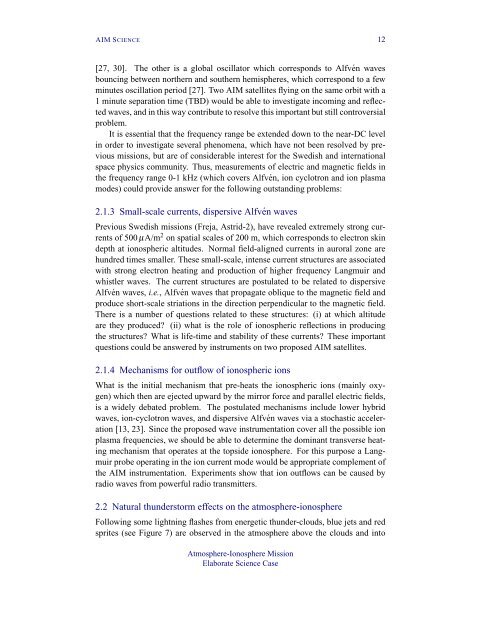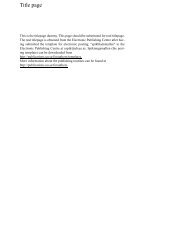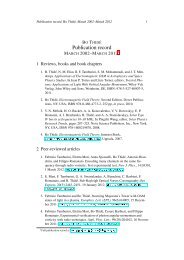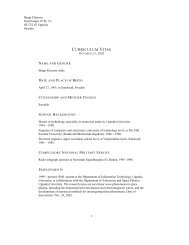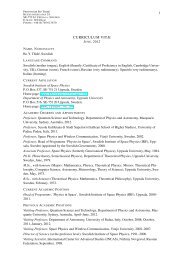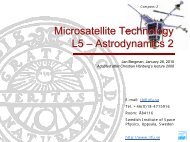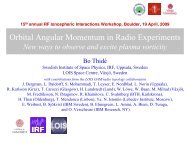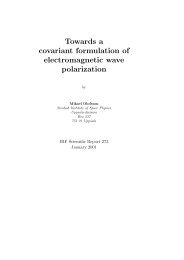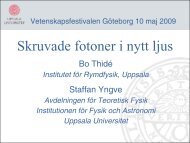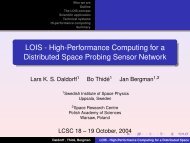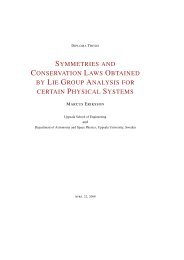Atmosphere-Ionosphere Mission - Swedish Institute of Space ...
Atmosphere-Ionosphere Mission - Swedish Institute of Space ...
Atmosphere-Ionosphere Mission - Swedish Institute of Space ...
Create successful ePaper yourself
Turn your PDF publications into a flip-book with our unique Google optimized e-Paper software.
AIM SCIENCE 12<br />
[27, 30]. The other is a global oscillator which corresponds to Alfvén waves<br />
bouncing between northern and southern hemispheres, which correspond to a few<br />
minutes oscillation period [27]. Two AIM satellites flying on the same orbit with a<br />
1 minute separation time (TBD) would be able to investigate incoming and reflected<br />
waves, and in this way contribute to resolve this important but still controversial<br />
problem.<br />
It is essential that the frequency range be extended down to the near-DC level<br />
in order to investigate several phenomena, which have not been resolved by previous<br />
missions, but are <strong>of</strong> considerable interest for the <strong>Swedish</strong> and international<br />
space physics community. Thus, measurements <strong>of</strong> electric and magnetic fields in<br />
the frequency range 0-1 kHz (which covers Alfvén, ion cyclotron and ion plasma<br />
modes) could provide answer for the following outstanding problems:<br />
2.1.3 Small-scale currents, dispersive Alfvén waves<br />
Previous <strong>Swedish</strong> missions (Freja, Astrid-2), have revealed extremely strong currents<br />
<strong>of</strong> 500 µA/m 2 on spatial scales <strong>of</strong> 200 m, which corresponds to electron skin<br />
depth at ionospheric altitudes. Normal field-aligned currents in auroral zone are<br />
hundred times smaller. These small-scale, intense current structures are associated<br />
with strong electron heating and production <strong>of</strong> higher frequency Langmuir and<br />
whistler waves. The current structures are postulated to be related to dispersive<br />
Alfvén waves, i.e., Alfvén waves that propagate oblique to the magnetic field and<br />
produce short-scale striations in the direction perpendicular to the magnetic field.<br />
There is a number <strong>of</strong> questions related to these structures: (i) at which altitude<br />
are they produced? (ii) what is the role <strong>of</strong> ionospheric reflections in producing<br />
the structures? What is life-time and stability <strong>of</strong> these currents? These important<br />
questions could be answered by instruments on two proposed AIM satellites.<br />
2.1.4 Mechanisms for outflow <strong>of</strong> ionospheric ions<br />
What is the initial mechanism that pre-heats the ionospheric ions (mainly oxygen)<br />
which then are ejected upward by the mirror force and parallel electric fields,<br />
is a widely debated problem. The postulated mechanisms include lower hybrid<br />
waves, ion-cyclotron waves, and dispersive Alfvén waves via a stochastic acceleration<br />
[13, 23]. Since the proposed wave instrumentation cover all the possible ion<br />
plasma frequencies, we should be able to determine the dominant transverse heating<br />
mechanism that operates at the topside ionosphere. For this purpose a Langmuir<br />
probe operating in the ion current mode would be appropriate complement <strong>of</strong><br />
the AIM instrumentation. Experiments show that ion outflows can be caused by<br />
radio waves from powerful radio transmitters.<br />
2.2 Natural thunderstorm effects on the atmosphere-ionosphere<br />
Following some lightning flashes from energetic thunder-clouds, blue jets and red<br />
sprites (see Figure 7) are observed in the atmosphere above the clouds and into<br />
<strong>Atmosphere</strong>-<strong>Ionosphere</strong> <strong>Mission</strong><br />
Elaborate Science Case


